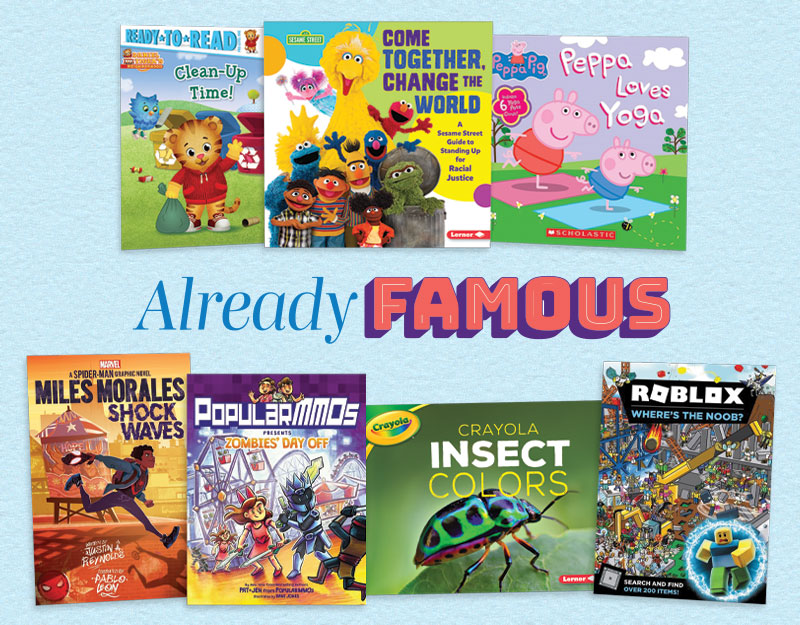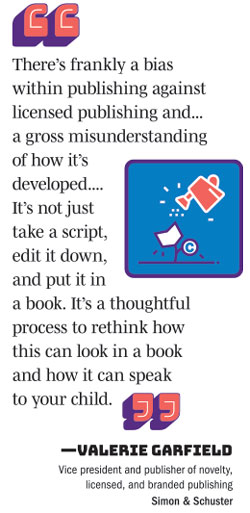Already Famous: Making the Case for Licensed Content Books
Though they are rarely recognized with merit awards, licensed content books are hugely popular and often timely—addressing social-emotional issues and, lately, concerns related to the pandemic—and the comfort of familiar TV and movie characters has strong appeal for beginning readers.

Peppa Pig and Daniel Tiger may not be considered literary characters, but their books fly off library shelves. That’s a good thing, librarians say. Licensed content books are often timely—addressing social-emotional issues and, lately, concerns related to the pandemic—and the comfort of familiar TV and movie characters has strong appeal for beginning readers.
While you probably won’t see these books sweeping the Youth Media Awards, they’ve gained broader acceptance among librarians. Publishers say their licensed content titles—children’s books featuring characters from TV shows, movies, or other properties—offer the same quality as other picture books or early readers, with the benefit of a lower price point.
“Our sweet spot, I would say, is preschool,” says Valerie Garfield, vice president and publisher of novelty, licensed, and branded publishing at Simon & Schuster, whose Simon Spotlight imprint is devoted to licensed content. Titles include books tied to the PBS series Daniel Tiger’s Neighborhood, Disney Junior’s PJ Masks, and an upcoming collaboration with the Netflix series CoComelon.
The licensed titles and series published at HarperCollins are “as varied as the kids who read them,” says Rich Thomas, director of publishing. Properties range from the PBS series Molly of Denali, the online game Roblox, and the educational entertainment company Pinkfong (known for “Baby Shark”) to Hasbro (My Little Pony) and YouTube personalities such as FGTeeV and PopularMMOs.
Publishers closely track the shows they like. “I had my eye on Peppa [Pig] for so many years, while she was growing in popularity in the U.K.,” says Debra Dorfman, Scholastic’s publisher of global licensing, media, and brands. “I was very excited when she came to the U.S.”
Dorfman was drawn to the themes and family dynamic portrayed in the TV show. “The relationship Peppa, her brother George, and their parents [have] was so authentic,” she says. “I loved that Mummy and Daddy Pig would talk to Peppa plainly about whatever situation they were in. From the early stages, the show was all about inclusivity, which really resonated with me.”
In addition to the popular Peppa Pig books, Scholastic titles with licensed content include Clifford the Big Red Dog, both the backlist and the PBS/Amazon TV series tie-ins; the Netflix series Julie and the Phantoms; and the Five Nights at Freddy’s horror game. Scholastic carries licensed content titles for preschool through young adult.
“We work with our partners on every aspect of the publishing programs,” says Lerner Publishing Group Editor-in-Chief Andy Cummings. “We have the mutual goal of just creating great educational books for kids.” Lerner currently partners with Sesame Street, Crayola, and Garfield the cat.
 Popular vs. literary
Popular vs. literary
Some licensed content books repeat story lines from episodes of TV shows, while others tell new stories. At Simon Spotlight, the book content goes beyond simply retelling what’s been on the show, Garfield says, and the imprint is selective about which properties it partners with. “It’s not just an apples to apples, you watched the TV show or you saw the movie, and here’s the exact replication of it in book form.” Instead, the books expand on story lines explored in an episode.
Cummings says that Lerner creates new content with its partners. Scholastic does both, Dorfman says.
Episodes of Peppa Pig, for instance, are short and can be viewed as a continuing story, so a book will combine several episodes. “There’s so many reccurring friends and characters. It’s pretty seamless,” Dorfman says. With a YA licensed property such as Riverdale, Lerner develops original stories. “We’re storytellers. We’re really known for our series publishing.”
Despite their popularity, licensed content books still don’t always get the same respect as other children’s books, Garfield says. “There’s frankly a bias within publishing against licensed publishing, and I think there’s a gross misunderstanding of how it’s developed and how it’s used. It’s not just take a script, edit it down, and put it in a book. It’s a thoughtful process to rethink how this can look in a book and how it can speak to your child. Everything we acquire, we think has some relevance in the publishing world, be it from a Daniel Tiger program that talks about social-emotional issues in a brilliant way as derived from Mister Rogers, to PJ Masks, which really talks about teamwork.”
Librarians acknowledge the bias, but many are also quick to point out the value of these books.
Jennifer Rothschild, collection engagement librarian at the Arlington (VA) Public Library, buys a lot of licensed content easy reader series. “If a reader doesn’t have to decode the characters and the world and the setting every time, that’s a lot easier for them,” and they can focus more on the words, she says.
Titles she buys include Peppa Pig, PJ Masks, Barbie, Daniel Tiger, Disney, Marvel and DC Comics titles, as well as titles based on the TV versions of original books, such as Llama Llama and Pete the Cat.
Rothschild says that the format can be a problem at her library, though. Much licensed content “isn’t published in a format that stands up to heavy library use,” she says. “In general, my library does not collect paperback picture books or paperback easy readers, which really limits the amount of licensed content I’m able to buy.”
Licensed content books, especially those in eight-by-eight paperback format, can get lumped in with other tie-in merchandise like toys in people’s minds, Rothschild says. Still, she adds, “I also don’t think every single thing we read, no matter our age, has to be the most literary thing in the world. As an adult, I don’t read only serious literary fiction. I don’t understand why we expect children to as well.”
Kristin Fletcher-Spear, administrative librarian at Glendale (AZ) Public Library, observes that youth and children’s librarians don’t always think to recommend licensed content titles to families. For instance, they may suggest the original Dinotrux books over the versions based on the Netflix show. “It’s the same as adult librarians who don’t like genre books, and they recommend more literary versions of the genre versus the genre authors.”
Thematic relevance and low prices
But younger kids want those specific characters and worlds, Fletcher-Spear says, because it’s comforting. “They know that Curious George is going to get into mischief and maybe learn a lesson. And Clifford is going to be a really big dog and that causes problems. But they like that. They watch the same shows over and over and over again.” Reading the books based on those shows, she says, can help build literacy.
The built-in star appeal can go a long way with kids. “Avid readers love to dive deeper into the worlds or characters they know from other forms of media,” says Thomas. “They are fascinated by the details of how their favorite developers create games, how the Roblox organization is run, or how Wonder Woman received her powers. For readers who are a bit more reluctant, licensed publications provide a welcoming gateway into the book world.”
“Over the years when I’ve talked to librarians, they see it as…‘If you can get a kid to read and into reading with their favorite characters, isn’t that a great thing?’” adds Dorfman.
The books especially appeal to reluctant readers, Garfield says. She sees a greater understanding in the school and library market that “breaking through to kids and being relevant in pop culture means embracing some of these licensed characters as well.”
“If it’s on TV and kids would ask for it, we have it,” says Fletcher-Spear. “[The books are] constantly checked out. People recognize them, they want them, their kids ask for them.”
Licensed content books can also handle timely stories more quickly, such as the Sesame Street books on topics like wearing masks and washing hands, Fletcher-Spear notes. Other Sesame Street titles focus on topics like mindfulness, community helpers, and the environment.
She actually prefers to buy eight-by-eight titles. “They’re a dime a dozen, and I don’t have to spend so much money on them,” so they’re easier to replace when they wear out.
Garfield says the books’ generally lower price points “create a threshold that allows more and more parents or caregivers to enter the publishing world a lot more easily. So if a parent is shopping at a Target or a Walmart and they see a book for $4.99, that’s a different experience than walking into a bookstore and looking at a picture book that’s $18.99.”
Lerner provides library-bound versions of all its titles and meets with librarians to get input, according to Cummings.
Regarding the books’ themes, Jenny Krueger, publishing director at Lerner, says Crayola and Sesame Street, especially, speak to their customer base of librarians and teachers; Crayola books use colors to teach about other topics, such as camouflage and communication in animals, while Sesame Street books focus on social-emotional learning.
Even Lerner’s Garfield titles deal with digital literacy and STEM, Krueger says. For instance, the “Garfield’s Guide to Digital Citizenship” series addresses topics like online friends and online etiquette. Initially, Krueger wasn’t sure about taking on the Garfield brand. “But when I talked to customers, they all said the exact same thing, which was: third grade, kids go through a Garfield phase.”
Recent Sesame Street titles include Stay Healthy with Sesame Street: Understanding Coronavirus and Caring with Bert and Ernie: A Book About Empathy. Krueger suggests the books’ popularity may be due to kids’ stress during the pandemic. “They have a lot of pressures on them,” and the books can “help them through difficult situations or even just celebrate the importance of play and creativity.”
Several publishers note that the current need for comforting books, as well as the business impact on licensing partners, appears to be affecting which titles sell. Thomas says that delayed theatrical releases or merchandising rollouts have affected some books, “particularly media tie-ins, which depend on mass awareness to lift book sales.” Readers want familiar brands instead, which “has lifted sales for many evergreen brands.”
He adds that the focus of the market has shifted along with media consumption, for instance, from film tie-ins to popular YouTubers.
At Scholastic, Dorfman says, “It’s been a little bit harder to introduce new properties. We’ve actually postponed a few, because retail has postponed some of the consumer products.” Backlist titles with Peppa Pig, Clifford, and Pokémon are selling well.
Garfield says that Simon & Schuster’s Daniel Tiger books have been selling briskly throughout the pandemic. In addition to CoComelon, out this summer, the publisher is launching its “ready to read” graphic novel program.
Dorfman says that upcoming titles include Scholastic's first Miles Morales graphic novel with Marvel, Shock Waves, by Justin A. Reynolds and illustrated by Pablo Leon, set for release in June.
Some of Lerner’s upcoming titles include Crayola’s Insect Colors, out in August, and Come Together, Change the World: A Sesame Street Guide to Standing Up for Racial Justice, slated for September.
These books offer “an easy way to meet kids where they are, especially if it gives them the confidence as they’re learning to read,” says Rothschild. “Then, they can also try other books.”
Marlaina Cockcroft is a freelance writer and editor in New Jersey.
RELATED
The job outlook in 2030: Librarians will be in demand
The job outlook in 2030: Librarians will be in demand
ALREADY A SUBSCRIBER? LOG IN
We are currently offering this content for free. Sign up now to activate your personal profile, where you can save articles for future viewing






Add Comment :-
Be the first reader to comment.
Comment Policy:
Comment should not be empty !!!